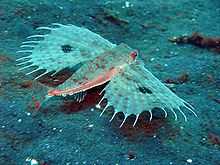Oriental flying gurnard
| Oriental flying gurnard | |
|---|---|
 | |
| Scientific classification | |
| Kingdom: | Animalia |
| Phylum: | Chordata |
| Class: | Actinopterygii |
| Order: | Scorpaeniformes |
| Family: | Dactylopteridae |
| Genus: | Dactyloptena |
| Species: | D. orientalis |
| Binomial name | |
| Dactyloptena orientalis (G. Cuvier, 1829)[1] | |
| Synonyms[1] | |
| |
Dactyloptena orientalis, known commonly as the Oriental flying gurnard or purple flying gurnard among other vernacular names, is a species of marine fish in the family Dactylopteridae.[2]Their name is derived from the French word 'gurnard' meaning to grunt, for the grunting sound this fish makes.
Description
The oriental flying gurnard can grow to 40 cm (16 in) in length but its common size is about 20 cm (8 in). It has a broad head with a blunt snout and the eyes are set a long way apart. It has a heavily-armoured robust body. The dorsal fin has seven spines and nine soft rays while the anal fin has no spines and six to seven soft rays. The huge, rounded pectoral fins having many dark spots and wavy streaks and a bright blue edge. Each ray has a feeler-like extension on the tip. This fish is well camouflaged with a grayish brown base color with dark brown or black markings on its head and body.[3][4]
Distribution and habitat
The Oriental flying gurnard is widespread throughout the tropical waters of the Indo-Pacific region including the Red Sea. Its range extends from the coasts of East Africa to Polynesia and the western, northern and eastern coasts of Australia. It is found on the seabed in bays and estuaries and sandy areas, most often at depths of about 10 m (33 ft) but sometimes as deep as 100 m (328 ft).[3][4]
Behavior
The pectoral fins are normally held against the body, but when threatened the fins are expanded to startle potential predators which may include sea breams and mackerel. The flying gurnard uses its pelvic fins to walk along the bottom of the ocean. The oriental flying gurnard feeds on small bony fish, bivalves, and crustaceans.[5]
References
- ↑ 1.0 1.1 Bailley, Nicolas (2013). "Dactyloptena orientalis (Cuvier, 1829)". World Register of Marine Species. Retrieved 2013-12-21.
- ↑ Common names of Dactyloptena orientalis FishBase
- ↑ 3.0 3.1 Dactyloptena orientalis (Cuvier, 1829): Oriental flying gurnard FishBase
- ↑ 4.0 4.1 Mark McGrouther (2013-09-04). "Purple Flying Gurnard, Dactyloptena orientalis (Cuvier, 1829)". Australian Museum. Retrieved 2013-12-21.
- ↑ Fischer, W., I. Sousa, C. Silva, A. de Freitas, J.M. Poutiers, W. Schneider, T.C. Borges, J.P. Feral and A. Massinga, 1990. Fichas FAO de identificaçao de espécies para actividades de pesca. Guia de campo das espécies comerciais marinhas e de águas salobras de Moçambique. Publicaçao preparada em collaboraçao com o Instituto de Investigaçao Pesquiera de Moçambique, com financiamento do Projecto PNUD/FAO MOZ/86/030 e de NORAD. Roma, FAO. 1990. 424 p.

.gif)
